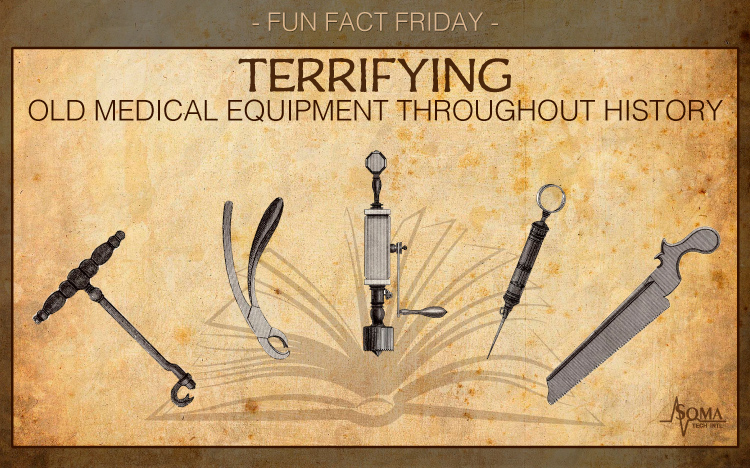Going to the doctor nowadays might seem daunting, but it’s nothing compared to what medicine was like centuries ago. Scary old medical equipment ranges from vaguely helpful but not worth the risk to things that make your sickness worse. Some of them could even be deadly. Possibly most frightening, these dangerous old instruments were completely accepted as the pinnacle of modern medicine at the time.
So, if you feel like being a little morbid and historic, delve into these horrifying ancient medicines. There are some pretty gruesome medical devices on here, so let’s hope you have a strong stomach.
THE CRUSHING METHOD OF INVERSION TRACTION
Hippocrates may be the father of modern medicine, but that doesn’t mean all his ideas were pure gold. If you had spinal trouble or joint pain around your neck and back in ancient Greece, one recommendation from ancient practitioners involved being stretched by your limbs and spine, often upside-down, using a rope and a wooden ladder. If this process sounds familiar to you, there’s a reason why. The rack was a torture device in medieval Europe centuries later, and it operated on the same stretching principle—with often deadly results.
A HOLE IN THE SKULL BY TREPANNING
Trepanning has been around for thousands of years and was practiced by cultures around the world—ranging from the ancient Greeks to the Aztecs. It consists of making a hole in the skull, for medical or religious reasons. Some cultures thought this would release demons, others did it to relieve cranial pressure, or increase intelligence. No device or any other old medical equipment used for trepanation is pretty. To say the least, many look like cookie cutters or blunt knives. Without any real antiseptic, no anesthesia, and no sterilization of instruments taking apart your skull made this instrument dangerous.
ANTIQUE SYRINGES
Although syringes are still in use today, during the 16th century syringes were much bigger. Its long thin tube and pump were much different from the hypodermics we use today. These syringes from the 1500s were often used to inject mercury as a treatment for syphilis, often contracted by amorous sailors on the high seas. With such a huge syringe, it became a urethral syringe. Worse yet, mercury often killed people long before diseases like syphilis complications could.
19th—20th CENTURY OLD MEDICAL EQUIPMENT
Medical devices from the early part of the 1800s and 1900s looked like torture devices dreamed up by the devil himself. They were so bizarre-looking in some cases, that medieval torture devices looked gracious by comparison. The terrifying technology behind the old medical equipment of the late 19th and early 20th century looks dated. But no matter how scary these devices appear, they paved the way for science and innovation, creating some of the most important advances in medicine today.
LITHOTOME CACHÉ
Nothing about the lithotome caché device is considered comfortable. By inserting a metal rod in your urethra as a catheter, the 18th-century French device was used to remove kidney stones. Then the doctor would make an incision directly into the membranous urethra, and insert the lithesome caché, within which were concealed blades. From the membranous urethra, the lithotome caché moves into the bladder, where it divides the neck of the bladder and prostate via a lever. Once the device was in place, forceps were used to remove the kidney stones.
ANTIQUE MEDICAL INSTRUMENT FOR AMPUTATION
Before general anesthetics were around, amputations were incredibly painful and incredibly dangerous. Bones were often splintered and the tissue around them was damaged by the harsh jolts of a saw. From the pre-antibiotic bacteria of old to the antibiotic-resistant bacteria of today, infection has always been a major reason for amputations. Nevertheless, doctors often took pride in the instruments used for this grizzly purpose. Saws had decorative swirls, groves, and other designs that were, ironically, probably also a place for germs to breed.
TONGUE ÉCRASEUR
The tongue écraseur might make you shudder. During the 19th century, people who had a tumor or an infected portion of the tongue had a semi-treatable option. Using a tongue écraseur, the device would cut off part of the infected tongue in quite a terrifying way. The device consists of a chain within a metal tube and a looped portion that protrudes from the end of the tube. This loop is placed around the infected part of the tongue and tightened until it slices away the infected area.
FINAL THOUGHT
Just in time for Halloween, these instruments are scary, yet real, devices that were actually used and even considered cutting-edge during their time. The road to modern medicine has been a long one, and doctors have come up with a variety of tools along the way. However, some of the early iterations were, shall we say, a little crude and terrifying. As scary as undergoing a medical procedure might currently be, we can only imagine how utterly terrifying it must have been in the not-so-distant past.
Which old medical equipment did you find the most frightening? Did you enjoy this article? Is there anything else you would like us to write about for Halloween? Leave us a comment below!


